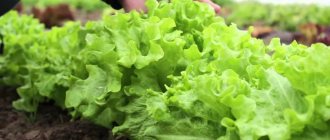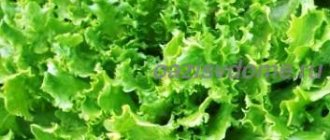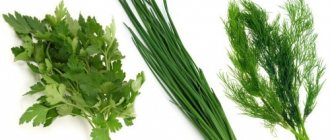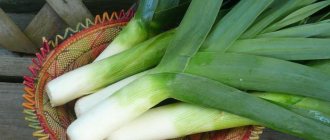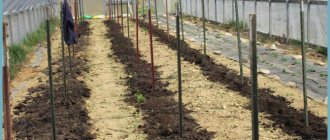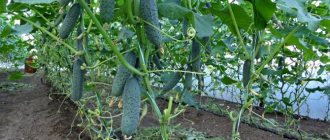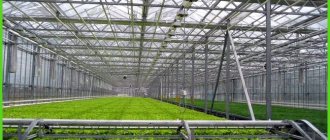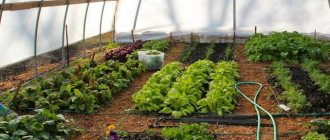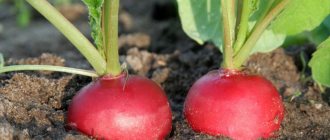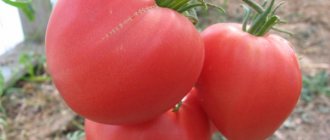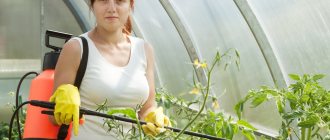Lettuce is a popular crop that can be grown in open ground, on a loggia or on a windowsill. but it is best to use greenhouses.
Indoor heated structures allow you to obtain a stable harvest throughout the year and enrich your diet with vitamins and valuable microelements.
Lettuce variety
Of these, early ripening species can be noted: “Emerald Lace”, “Moscow Wig”, “Parliament”. 20 days after planting, they form a powerful rosette consisting of a dozen leaves of marketable appearance. The optimal temperature for them is +20°C, but plant growth is possible even at +5°C.
Planting is done in rows, the distance between which should be at least 20 cm. Thickening of the seeds is allowed, which is subsequently neutralized by thinning. A temporary decrease in temperature in the greenhouse is not critical. Plant seeds remain viable even at +4-5°C, and the emerging seedlings can even withstand a slight frost down to –2°C.
Important! Knowledgeable people recommend using coated seeds, the germination rate of which is much higher than that of ordinary ones.
Harvesting
A formed rosette of leaves or sufficient density of the head of cabbage indicates that it is time to harvest the greens.
Dry weather is an excellent time for cleaning, for which we set aside early morning or evening hours. During hot weather or immediately after precipitation, we do not carry out harvesting, due to the fact that it is precisely such conditions that subsequently lead to a rapid deterioration in the quality of the harvested crop, as well as its rapid decay.
We harvest leaf and head lettuce a little differently. For the first we use mass cleaning, but for the second we approach it selectively, that is, we focus on the maturity of the head of cabbage.
And one more thing - to use for food, we take fresh leaves or heads of cabbage before the flower arrow pops out, otherwise, with its appearance, bitterness accumulates in the leaves.
Headed varieties of lettuce
The Bitner variety ripens in 35–45 days. Once formed, the heads of cabbage should be cut off and consumed when ripe, since after 3–5 days they will already form a flower stem.
“May” - heads of cabbage appear a little later, 2 months after germination.
“Paris Green” is the most common late-ripening variety; it is grown both by sowing lettuce in the ground with seeds and through seedlings. When sown with seeds, it produces vitamin-rich greens 2 months after germination. Heads of cabbage weigh 100–150 g, their yield reaches 3–4 kg. per square meter.
Gerberas in pots: care at home
Hydrangea photo garden planting and care
Hibiscus: planting and care in open ground
Sowing rules
First, prepare a suitable soil mixture. To do this, mix high-quality humus soil, peat and sand (2:1:1). If you have the opportunity and desire, then buy a ready-made soil mixture, which can be found on the store shelf; “Vegetable”, “Universal” and “Biosoil” are best suited. It is recommended to sow in containers or boxes, but experienced gardeners advise using pressed peat cubes with a side of 40–50 mm for this.
Just before sowing, the seeds are immersed in a pink potassium manganese solution for 2–3 hours. Then they are evenly distributed on the surface of the substrate without embedding. If sowing is done in a box, then you first need to make grooves in the soil mixture into which the seeds are placed evenly, and they should be buried no more than 10 mm into the substrate. If, as the seedlings grow, you want to pick them out, then the row spacing should be about 50 mm. But you don’t have to pick the seedlings; in this case, you need to leave a distance of at least 100 mm between the rows. Crops need abundant watering, which must be done very carefully, then the container is covered with glass or film on top. Experts advise removing the seedlings to a well-lit place with an air temperature of 18 to 21 degrees. The first seedlings may appear after 3-4 days, immediately after this the temperature should be reduced by 3 or 4 degrees, otherwise the plants may begin to stretch.
If the bushes need picking, then it is carried out after 1 or 2 true leaf plates have formed on them. Seedlings are planted in open soil when 3 or 4 true leaf blades are formed. But first they need to be hardened for 15 days. To do this, the seedlings are transferred outside every day, and the duration of this procedure should be increased gradually. The seedlings will harden completely after they can stay in the fresh air around the clock. If the lettuce is grown indoors, it does not need to be hardened.
Greenhouses for growing lettuce in winter
Any type of greenhouse is suitable for growing plants, such as light summer greenhouses covered with plastic film, and permanent structures made of metal profiles, covered with polycarbonate or glass. If light greenhouses allow you to somewhat lengthen the growing season of plants, then in permanent buildings you can grow lettuce all year round. Structurally, a greenhouse for growing this crop is no different from similar buildings for other vegetables. The dimensions of the buildings can be completely arbitrary, and double glazing and the presence of a vestibule at the entrance will allow you to preserve plants even in the coldest winter. It is necessary to have windows for ventilation, additional lighting and a drip irrigation system.
Soil requirements
The root of the lettuce, even the most powerful one, is small.
At the same time, it holds a considerable load - lettuce spreads leaves, cabbages form heads, asparagus shoots out thick stems, as thick as an arm.
All this, of course, requires intensive nutrition.
Therefore, it is illogical to expect a known good harvest on scarce land. The soil needs to be nutritious, fertilized, preferably with organic matter.
You can add minerals to it before planting, but it’s worth remembering: this is still “chemistry”, and it will immediately rush into the leaf.
The mass for which we grow this miracle vegetable, famous for its variety of types and forms, is lettuce.
If the nutritional components extracted from organic fertilizer (semi-rotted manure, matured compost) are sent there, this is a natural process. Natural.
Organic compounds will easily integrate into the structure of plant cells, and then, already in the product, our body will accept them just as naturally.
Caring for health is a priority over the primitive desire to “kill the worm” with something. It is better to feed it with healthy products.
Therefore, while avoiding synthetic drugs whenever possible, let us remember: the environment is important.
So, the first step is wisely fertilized soil. Better: fertilized in the fall. Why?
Because organic matter will be distributed evenly over the autumn-winter period, the plant that has begun to vegetate will not experience overfeeding.
It will take as much as it optimally requires for the formation of leaf mass.
The soil must be loose. Organics usually keep it in this state.
But if there is loam there, it won’t hurt to add some sand when digging.
We remember: the root is small, its tasks are great. In dense soil with them, it may not work at full strength.
Will help:
- Autumn digging with organic matter and (possibly, if necessary) adding sand;
- Pre-sowing spring early digging and harrowing - loosening the area;
- Providing drainage. This also works for the structure. Overmoistening of soils, no matter how well-fed and structural, will inevitably lead to their compaction. And it’s not difficult to avoid this - in climatically damp regions there are either raised beds for lettuce, or a drainage layer/drainage grooves around the beds.
- If there is an excess of moisture, the root will become wet. If there is a deficiency, it will also die. Hence: the soil on the site must be provided with moisture. Either this is initially an area with optimal moisture, or it will be necessary to ensure the availability of irrigation water. Lettuce is moisture-loving; without moisture it is impossible to form a powerful mass, and this is the gardener’s goal, a harvest of green mass.
- According to its preferences, the salad does not tolerate acidic soils, although it tolerates mild acidity. Check the area for acidity, at least for herbs that you did not sow there (weeds). We found woodlice, plantain, knotweed - think about it. These herbs settle precisely in acidified, albeit moderate, places. Perhaps there are plots on your site where the plantain is in no hurry to attack? Consider them for other parameters; it may be suitable for successfully growing lettuce.
If there are signs of high acidity, it is better to lime the area, because most cultivated plants do not like acidic soils, gravitate towards neutral soils or tolerate slightly alkaline soils.
Advantages of growing lettuce in a greenhouse in winter
Growing lettuce in a greenhouse all year round has practically no disadvantages or difficulties. But there are many advantages to such planting.
- green crops grow quickly;
- salads are very healthy. They contain a large amount of water, valuable fiber, vitamins B, C, K, potassium and folic acid. The most useful are juicy varieties of bright colors;
- the taste of lettuce grown indoors is no different from the taste of plants from the garden;
- there are seeds of different varieties on sale, from simple to exotic;
- lettuce can be grown both in a heated greenhouse and in a summer greenhouse;
- you can plant different varieties of lettuce for the greenhouse, combining them with other spicy herbs and vegetables;
- a heated greenhouse makes it possible to harvest crops all year round, including in winter;
- a summer greenhouse without additional heating significantly extends the growing period, allowing you to save on heating;
- The yield of lettuce in a greenhouse is higher than in open ground, the plants are protected from pests and adverse weather conditions.
Soil preparation
We partially touched on this issue when choosing a cultural site. Having already structured, fertilized, drained soil, preparing it for sowing will not be difficult.
Lettuce is an early crop. Therefore, before sowing, all that remains is to form (if necessary) ridges for it and keep them in a loose state.
It is convenient to loosen with a flat cutter, destroying the soil crust, at the same time it destroys the still thin shoots of cold-resistant weeds.
Do not allow the area to stand under the crust for a long time; even deep-lying moisture evaporates through its cracks very quickly.
It is evenly distributed in the soil layer; it is unwise to lose it. Irrigation water will not fit so organically into the soil structure; it can easily be over-watered or under-watered.
And we strive for the optimum, for the ideal for growing our lettuce. Fertile conditions are important for any culture.
In practice, it often does not have time to reach the soil crust. Lettuce does not wait for the heat; it is sown earlier.
Feeding lettuce in a greenhouse in winter
If the soil is sufficiently fertile, then it is not advisable to feed the crop. On depleted soils, fertilizing is carried out once with a solution of nitrophoska (10-15 g/10 l of water) or ammonium nitrate (15-20 g/10 l of water) 2 weeks after planting. For feeding, you can use a solution of a mixture of 20 g of water-soluble superphosphate and potassium sulfate per 10 liters of water.
Mix the solutions thoroughly and pour from a fine-mesh watering can. The fertilizer solution should always be washed off the leaf surface with clean water. You can sprinkle the soil with wood ash - a source of micro and macroelements in an accessible form.
Care
Caring for leaf lettuce crops consists only of timely watering, loosening the soil and removing weeds.
It is necessary to water once a day in dry weather and 2 - 3 times a week in cool and cloudy weather. This is best done by sprinkling after sunset. You cannot water lettuce from a watering can on a hot day , as wet leaves will wither.
It is not necessary to fertilize, since the crop is early ripening. It is better to add all the necessary microelements in advance. Only in exceptional cases can you combine watering with fertilizing by adding a little manure to a bucket and carefully hanging it in the water.
Lettuce pests cannot be controlled using chemicals. You can use only natural remedies, garlic infusions, biological products.
If a disease is detected on a lettuce plant (root rot or other), it must be completely removed immediately so that the disease does not spread.
Diseases and pests
The main problems that can be encountered in the process of growing lettuce are:
- aphids, slugs and snails;
- fungal diseases;
- weeds.
Growing lettuce near onions will prevent aphids
The successful fight against the above troubles is based on a number of preventive measures, the most effective of which are:
- Properly selected rotation of plant crops in the greenhouse.
- Timely removal of weeds and loosening of the soil.
- Maintaining optimal temperatures and humidity levels.
Attention! It is good to plant lettuce next to plants such as cabbage, radishes, radishes - it repels flea beetles. It is also useful for salad to be near onions, which prevent the appearance of aphids.
